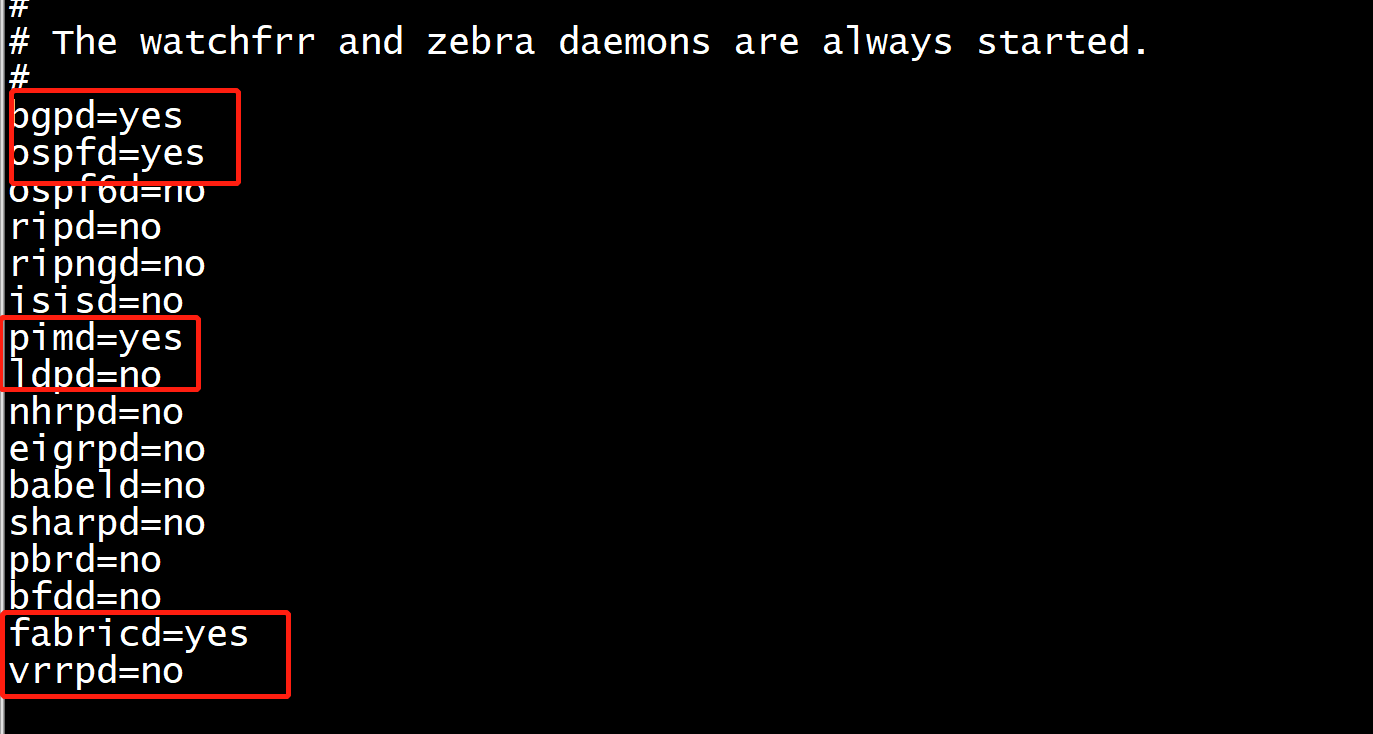frr 配置
[root@host-10-10-18-195 ~]# chown frr:frr /var/log/frr/ [root@host-10-10-18-195 ~]# vtysh Hello, this is FRRouting (version 7.3-MyOwnFRRVersion). Copyright 1996-2005 Kunihiro Ishiguro, et al. host-10-10-18-195# log file /var/log/frr/frr.log % Unknown command: log file /var/log/frr/frr.log host-10-10-18-195# config host-10-10-18-195(config)# log file /var/log/frr/frr.log host-10-10-18-195(config)# write % Unknown command: write host-10-10-18-195(config)# exit host-10-10-18-195# write Note: this version of vtysh never writes vtysh.conf Building Configuration... Configuration saved to /etc/frr/zebra.conf Configuration saved to /etc/frr/bgpd.conf Configuration saved to /etc/frr/staticd.conf host-10-10-18-195# exit

[root@evpn2 ~]# cat /etc/frr/daemons # This file tells the frr package which daemons to start. # # Sample configurations for these daemons can be found in # /usr/share/doc/frr/examples/. # # ATTENTION: # # When activating a daemon for the first time, a config file, even if it is # empty, has to be present *and* be owned by the user and group "frr", else # the daemon will not be started by /etc/init.d/frr. The permissions should # be u=rw,g=r,o=. # When using "vtysh" such a config file is also needed. It should be owned by # group "frrvty" and set to ug=rw,o= though. Check /etc/pam.d/frr, too. # # The watchfrr and zebra daemons are always started. # bgpd=yes ospfd=yes ospf6d=no ripd=no ripngd=no isisd=no pimd=yes ldpd=no nhrpd=no eigrpd=no babeld=no sharpd=no pbrd=no bfdd=no fabricd=yes vrrpd=no # # If this option is set the /etc/init.d/frr script automatically loads # the config via "vtysh -b" when the servers are started. # Check /etc/pam.d/frr if you intend to use "vtysh"! # vtysh_enable=yes zebra_options=" -A 127.0.0.1 -s 90000000" bgpd_options=" -A 127.0.0.1" ospfd_options=" -A 127.0.0.1" ospf6d_options=" -A ::1" ripd_options=" -A 127.0.0.1" ripngd_options=" -A ::1" isisd_options=" -A 127.0.0.1" pimd_options=" -A 127.0.0.1" ldpd_options=" -A 127.0.0.1" nhrpd_options=" -A 127.0.0.1" eigrpd_options=" -A 127.0.0.1" babeld_options=" -A 127.0.0.1" sharpd_options=" -A 127.0.0.1" pbrd_options=" -A 127.0.0.1" staticd_options="-A 127.0.0.1" bfdd_options=" -A 127.0.0.1" fabricd_options="-A 127.0.0.1" vrrpd_options=" -A 127.0.0.1" # configuration profile # #frr_profile="traditional" #frr_profile="datacenter" # # This is the maximum number of FD's that will be available. # Upon startup this is read by the control files and ulimit # is called. Uncomment and use a reasonable value for your # setup if you are expecting a large number of peers in # say BGP. #MAX_FDS=1024 # The list of daemons to watch is automatically generated by the init script. #watchfrr_options="" # for debugging purposes, you can specify a "wrap" command to start instead # of starting the daemon directly, e.g. to use valgrind on ospfd: # ospfd_wrap="/usr/bin/valgrind" # or you can use "all_wrap" for all daemons, e.g. to use perf record: # all_wrap="/usr/bin/perf record --call-graph -" # the normal daemon command is added to this at the end. [root@evpn2 ~]#



 浙公网安备 33010602011771号
浙公网安备 33010602011771号